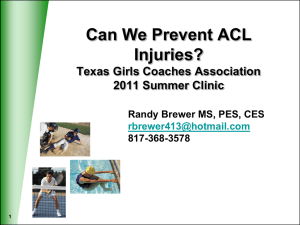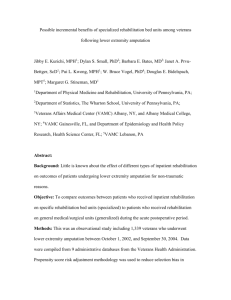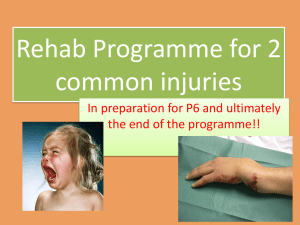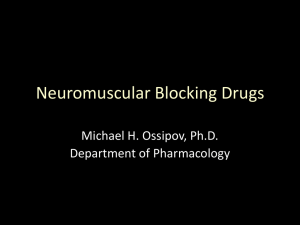Research Paper
advertisement
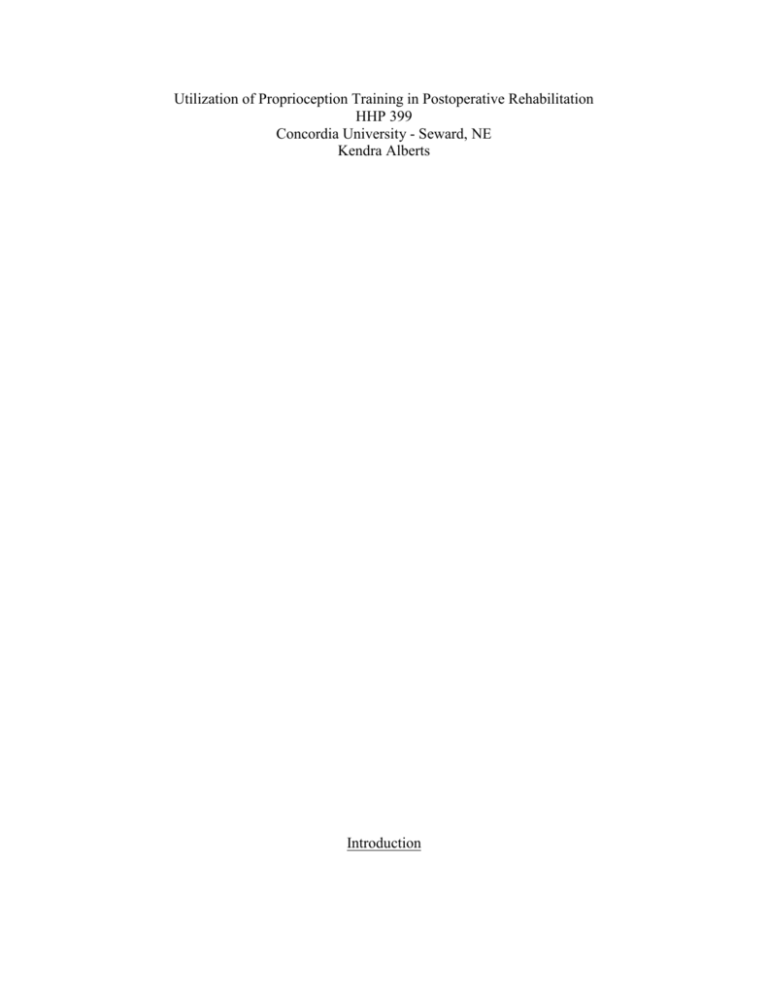
Utilization of Proprioception Training in Postoperative Rehabilitation HHP 399 Concordia University - Seward, NE Kendra Alberts Introduction At some moment, an athlete may experience a traumatic event that appears to be detrimental to their sport career. However with the right rehabilitation, an athlete can eventually return to the field of play. There are two methods of recovery that an athletic trainer or physical therapist may use on the athlete. These methods are as follows: neuromuscular training and traditional resistance training. Neuromuscular training involves the use of balance exercises, dynamic joint stability exercises, plyometric exercises, and agility drills or sports specific exercises. Neuromuscular training has been hypothesized to increase joint stability through a variety of mechanisms including muscle strength, kinesthesia, and muscle tone (Baltaci & Kohl, 2003). The use of traditional resistance training consists of strengthening exercises that involve primarily the muscles of lower extremities. During resistance training, the injured athlete will be performing exercises that have an emphasis on the quadriceps femoris, hamstring, gluteus medius and gastrocnemius muscles. Sports medicine practitioners have begun to realize that factors proximal the site of the injury, such as hip muscle weakness, may play a role in lower extremity injury potential. Historically, examination findings and treatments by sports medicine practitioners have focused directly on or distal to the site of pain, with no investigation of proximal findings. Significant weaknesses have been discovered in all categories of injury. More specifically hip abductor and adductor weakness in lower extremity injuries. Hip muscle weakness resulting in the lack of proximal control of the leg is a risk factor of lower extremity athletic injuries (Niemuth, 2007). Studies have found this to be particularly evident in female athletes. An assessment of strength in these regions can be performed prior to season training and after season training to record the development of strength throughout the program. The young athletes and active individuals participating in various sports activities are at risk for injuring themselves. Due to the lack of hip muscle strength one is more susceptible to injury. The ACL and MCL of the knee are especially susceptible to injury. The frequency of injury to these two ligaments account for 90% of all injuries to the knee (Woo et al., 2004). Woo and associates estimated that 150,000-200,00 new ACL injuries and 140,000 new combined ACL and MCL injuries occur annually. Of notable concern is the rise of injury to these injuries. The inherent risk of injury in any athletic or exercise event is unavoidable, however injury due to significant weaknesses in the lower extremities can be easily fixed with an appropriate workout routine. Statement of the Problem This study will identify the benefits of neuromuscular training in postoperative rehabilitation versus traditional resistance training with the athletes of Concordia University. It will acknowledge the use of the two methods and which professionals prefer to use. Purpose of the Study The purpose of this study is to determine the rehabilitation methods of neuromuscular training in postoperative rehabilitation versus the methods of traditional resistance training, and using these findings to compare the utilization of either rehabilitation method. Significance of the Study A brief amount of medical research has been dedicated to the topic of neuromuscular training versus traditional resistance training. However, there has been a considerable amount of research dedicated to the individual topics. Injuries to the lower extremities are very common in sports. Mechanisms for athletic injuries are often multifactorial and they are often as a result of anatomical, biomechanical, and environmental causes. Past studies have been dedicated to the contribution of biomechanics and orthopedics in postoperative rehabilitation. Today, athletic trainers and physical therapists use a combination of both neuromuscular and traditional resistance training for rehabilitation of their patients and athletes. More sophisticated equipment and analyses have become available to perform better experiments that yield a much better understanding of joint kinematics and tissue function during exercise and many daily activities. Injuring the anterior cruciate ligament is a serious knee ligament injury. Following injury, there are two main impairments: lack of neuromuscular control and muscular strength. The reestablishment of the neuromuscular control of the lower extremity is one of the keys to restoring dynamic joint stability and functional movements patterns. The goal to recreating this neuromuscular control is to avoid subluxations and to the lower the risk of further injuries. The chance of the injury reoccurring is existent in all cases, but with neuromuscular control this risk can be decreased. Solutions to normalizing dynamic knee joint stability and muscular strength of the lower extremity is significant in this study. These findings will aim to make rehabilitation programs for people with ACL injury based upon the solutions. Definition Terms • Proximal: situated nearer to the center of the body or the point of attachment. • Distal: situated away from the center of the body or from the point of attachment. • Neuromuscular Training: training related to nerves and muscles. • Resistance Training: training specializing in the use of resistance to induce muscular contraction which builds the strength, anaerobic endurance, and size of skeletal muscles. • Kinematics: study of movement from a geometrical point of view. • Adductor: a muscle whose contraction moves a limb or other part of the body toward the midline of the body or toward another part. • Abductor: muscle whose contraction moves a limb or part away from the midline of the body. • Proprioception: inborn kinesthetic awareness of body posture including movement, tension, and changes in the equilibrium Research Questions This study will seek to resolve the following questions about neuromuscular training versus traditional resistance training: What are the benefits of using both training options together and by themselves? What are the most common forms of neuromuscular training being used today? Do therapists and sports medicine personnel have a preference of training over the other? Literature Review Some researchers have reported differences in neuromuscular performance in ACL deficient and reconstructed knees. Other researchers have highlighted the importance of regaining quadriceps femoris muscle strength following ACL reconstruction. Therefore, both muscle strengthening programs and neuromuscular training programs have been implemented in rehabilitation to restore knee function after ACL injury and reconstruction. Several neuromuscular training programs have been evaluated through studies for injury prevention for patients with ACL deficiencies but the studies have not evaluated the thoroughness of neuromuscular training for patients with ACL reconstruction. Only a few studies have been conducted to determine the differences between neuromuscular training and resistance training. Therefore, more evidence is required to identify the obvious differences among the exercises used in clinical settings for rehabilitation after ACL reconstruction. In all, the results of the study showed minimal differences between the neuromuscular training program and the resistance training program. In the ability to improve knee function after ACL reconstruction, the neuromuscular program was superior to the resistance training program. However, there are not any significant differences between the two programs for other outputs. Together, these programs provided similar improvements when it came to overall strength, balance, and proprioception (Risberg et. al, 2007). Anterior cruciate ligament reconstruction is a standard practice for those who wish to return to any sort of high level activities. However, the functional outcome after ACL reconstruction is poor. Quadriceps strength weakness, abnormal movement patterns, and below normal function from the injured extremity have been reported during the time after reconstruction. Therefore, neuromuscular training is necessary for the improvement of outcomes during postoperative rehabilitation. Not only should one focus on the treatment methods during post-operation but they should also focus on preoperative strengthening. Preoperative neuromuscular training programs have been successful at improving limb symmetry prior to surgery. Although the benefits of preoperative strengthening are not long lasting, they have been helpful in the success of improving postoperative deficits and lowering the risk of second injury. Success after ACL reconstructive surgery is measured by using the return to sport rates. Despite that second ACL injuries are not only common, they are even more devastating than the first and typically have worse outcomes. The risk of second ACL injury is the highest during the first year that the individual returns to the field of play after their ACL reconstruction. Also, research shows that risk to the contralateral limb is higher than the operated limb due to limb asymmetries. However, a neuromuscular training program that is focused on maximizing performance after ACL reconstruction may be able to reduce the risk of a second ACL injury. Research has shown neuromuscular training, consisting of destabilizing disturbances to both the involved and uninvolved extremities, has been an effective means of enhancing functional outcome after ACL reconstruction compared to the traditional resistance training methods. Successful ACL prevention programs use a combination of balance, plyometric, and strengthening exercises to decrease ACL injury risks. Specialists focus on incorporating dynamic prevention exercises and quadriceps strengthening exercises that promote symmetrical joint loading and decrease abnormal movement patterns to resolve remaining impairments after surgery (White et al., 2013). Among the most common injuries, in daily and sport activities, are knee and ankle injuries. The terms related to these injuries are ‘proprioceptive deficit’, ‘proprioceptive training’, and ‘proprioceptive rehabilitation’. These terms are being tossed around more frequently in the sports medicine field. Medical professionals need a general understanding of the afferent proprioceptive system and its importance in joint function. They must be aware of how to incorporate this ‘proprioceptive training’ during rehabilitation. They observe a decreased range of motion, decreased strength of knee extensors, and a decrease in joint proprioception as being factors that contribute to functional knee and ankle instability. Proprioception refers to the “inborn kinesthetic awareness” of body posture including movement, tension, and changes in the equilibrium involving the affected joint. In the absence of mechanical stability symptoms of functional instability are reported. An optimal rehabilitation program must acknowledge the activity to which the patient will return. By taking into consideration the level of activity one will be experiencing, the therapist is better able to make a rehab program for the individual. Rehabilitation of the knee or ankle will concentrate on specific groups for each area. For example, the therapist must consider the explosive power used for acceleration in sprinting for a track athlete when creating a rehabilitation program. Therefore, rehabilitation of an injury must consider restoring the proprioception sense. Typically, this can be done by the restoration of neuromuscular function in ACL deficient patients by focusing on training the thigh muscle for strength. Emphasis on the proprioceptive function of the ACL can enhance our understanding of why reconstructions do not create the normal knee that once existed. Without proper training, the proprioceptive sense that existed before the ACL injury can interrupt the ACL-muscle reflex arc. This impedance triggers a slower pathway that may produce abnormal muscle activation patterns of the hamstrings and quadriceps. Overall reducing the dynamic stability of the extremity (Baltaci and Kohl, 2003). Neuromuscular electrical stimulation can be a beneficial supplement to traditional forms of postoperative therapy. There has been a significant increase in results when using neuromuscular electrical stimulation. However, there has also been results with minimal or no difference when neuromuscular electrical stimulation was used to strengthen the muscles affected during postoperative rehabilitation. The primary objective during postoperative rehabilitation is to reduce inflammation, regain neuromuscular strength and functional performance, recover normal range of motion and reintegrate the patient to everyday activities. Recent reviews conclude that rehabilitation training with neuromuscular electrical stimulation superimposed on voluntary contraction was better than either neuromuscular electrical stimulation or voluntary contraction practiced separately. When both ways of treatment are used, either neuromuscular electrical stimulation or non-neuromuscular electrical stimulation, there will be positive results in each. However, when neuromuscular electrical stimulation is used the strength and functional performance results are consistently better. With the use of neuromuscular electrical stimulation and other conventional rehabilitation methods, patients could be able to return their everyday activities days sooner than those who may not use the method of neuromuscular electrical stimulation. (Feil, et al., 2011). Methodology A survey was administered to a team of professionals that were either certified athletic trainers or physical therapists. This survey provided an overview of the different aspects addressed by this study. A survey was conducted with multiple choice questions and short answer questions. This survey was sent to a small number of professionals with four out of the five responding. Of these participants, three were in the age range of 25-30 and one between the age range of 45-50. I thought these age factors may cause an interesting pattern in results due to the continuous advancement that takes place in therapy. Typically the older population of therapists and trainers will use different methods of therapy for rehabilitation because these methods are what they learned in school. However, all four participants chose similar answers proving this hypothesis invalid. Possibly the requirement of keeping up to date with the newest techniques can be a factor for this result. The survey itself was created to get a general consensus about what rehabilitation methods therapists and trainers use and/ or prefer. This enabled for the analysis of neuromuscular training versus traditional resistance training for postoperative rehabilitation. The survey asked a series of questions pertaining to the use of each therapy method and the preference of each therapist or trainer. These questions were created to be effective in compiling an amount of data surrounding the topic being analyzed between neuromuscular training and traditional resistance training. The study was administered through an email and an online survey that was sent out to the participants, asking for their patience and participation. After the ten days concluded, results were collected and ready to be analyzed. The survey that was administered is on page 16. Data Collection & Analysis After the surveys had been taken, responses were recorded and then evaluated. Software through Survey Monkey was used to evaluate data. Each aspect of the study was looked at within the different questions to determine any information that may be valuable to the research process. Results The results of this study were fairly straightforward and slightly expected. 100% of the participants were familiar with both methods of therapy. 100% of the respondents preferred a combination of both neuromuscular training and traditional resistance training for postoperative rehabilitation. When focusing on the prevalence of ACL injuries per year, 66.7% involved 1-5 ACL injuries while 33.3% involved 6-9 ACL injuries. However, there was variation in answers when focusing on the strength of lower extremity muscles during postoperative rehabilitation. A 100% was received for both the Quadriceps Femoris and Hamstring muscles, but 66.7% was received for Gluteus Medius and 33.3% for the Gastrocnemius. The purpose of this study was to determine the rehabilitation methods of neuromuscular training in postoperative rehabilitation versus the methods of traditional resistance training. The results show the familiarity of each form of rehabilitation. The following graphs provide a visual of the results for the data collected. The first graph illustrates the different sport teams each professional works with. The latter graphs demonstrate the prevalence of injuries among the sports, preferred neuromuscular training methods, and lower extremity muscles emphasized during postoperative rehabilitation. Discussion & Recommendations Prior to the survey, I was curious to see how the results would pan out. I thought there might be a difference in the use of therapy methods. However, I was proved wrong. Results show that physical therapists and physical therapists use similar methods of training for rehabilitation. Typically, athletic trainers focus on acute care and prevention. They go through a different schooling process to obtain their degree. While therapists are required to go to school for three full years after their undergraduate studies to obtain their Doctorate’s Degree. Therefore, the reasoning for my curiosity in the prescription and use of both therapy methods between each group of survey participants. Analysis of the data from this study showed that there was no difference in selection of rehabilitation methods. Relatively both rehabilitation methods were popular among the two groups. This does not mean that all athletic trainers and physical therapists prefer a combination of both methods since a small group was surveyed. Although, each therapist and trainer will have their own opinion in the use of particular methods, the trend from this survey shows there is a preference for each. Today, researchers are unable to prove that a particular rehabilitation method is better than the other. The fact is that both rehabilitation methods have been used for years by physical therapists and athletic trainers. Success from postoperative treatment provides proof for the use of a combination of each method. Research has shown that there is a significant increase in return to the daily activities when using a form of neuromuscular training paired with traditional strength training during postoperative rehabilitation. Dear Participant, The purpose of this study is to determine the benefits of neuromuscular training in postoperative rehabilitation versus the use of traditional resistance training, and using these findings to compare to the incidence rates of injury. There are three main objectives for this study. They are as follows: a) to determine the benefits of using both training options together and by themselves, b) to determine the common forms of neuromuscular training being used today, and c) to determine if specialists in the field have a preference of training techniques over the other. You are invited to participate in this study because you are a specialist in the field of rehabilitation for injuries. Participation in this study will require approximately 5-10 minutes of your time. You will complete a 12-question survey and then be asked for any additional thoughts about any of the topics or the survey itself. The information gained from this study may help us to better understand a) the benefits of neuromuscular training and strength training techniques, b) common forms of neuromuscular training and strength training, and c) the preference of training being used today. Any information obtained from this survey will be kept confidential. The information taken from this will be used to progress the results of this study. Please follow the link below to participate in this survey: https://www.surveymonkey.com/s/HG7N5J5 Thank you for your time and participation in our study. Kendra Alberts 1. What sport teams do you typically work with? Please check all that apply. Baseball Men’s Basketball Women’s Basketball Men’s Cross Country Women’s Cross Country Dance Football Men’s Golf Women’s Golf Men’s Soccer Women’s Soccer Softball Men’s Tennis Women’s Tennis Men’s Indoor Track and Field Women’s Indoor Track and Field Men’s Outdoor Track and Field Women’s Outdoor Track and Field Volleyball Wrestling 2. What is the prevalence of ACL injuries within the sports teams you work with? 1-5 6-9 10-15 16-19 20-25 26-30 3. Are you familiar with the use of neuromuscular training as a postoperative rehabilitation method? Yes No 4. Are you familiar with the use of strength training as a postoperative rehabilitation method? Yes No 5. Do you agree with the use of preoperative strengthening of the affected extremity? Yes No 6. Which forms of neuromuscular training are you most familiar with? Please check all that apply. Balance exercises Dynamic Joint Stability exercises Plyometric exercises Agility Drills Sport Specific exercises If none of these apply please list.. 7. When focusing on the strength of the lower extremity, which muscles do you place the most emphasis on? Please check all that apply. Quadriceps Femoris Hamstring Gluteus Medius Gastrocnemius. If none of these apply please list.. 8. Do you have a preference of training type for postoperative rehabilitation over the other? Or do you prefer a combination of both? 9. What is your gender? Female Male 10. How old are you? 11. Which academic institution did you earn your advanced degree from? 12. Please feel free to express any other information you feel would contribute to this survey. References Baltaci, G., & Kohl, H. W. (2003). Does proprioceptive training during knee and ankle rehabilitation improve outcome?. Physical Therapy Reviews, 8(1), 5-16. Feil, S., Newell, J., Minogue, C., & Paessler, H. H. (2011). The effectiveness of supplementing a standard rehabilitation program with superimposed neuromuscular electrical stimulation after anterior cruciate ligament reconstruction: a prospective, randomized, single-blind study. The American Journal of Sports Medicine, 39(6), 1238-1247. Niemuth, P. (2007). The role of hip muscle weakness in lower extremity athletic injuries.. International SportMed Journal, 8(4), 179-192. White, K., Stasi, S. L., Smith, A. H., & Snyder-Mackler, L. (2013). Anterior cruciate ligamentspecialized post-operative return-to-sports (ACL-SPORTS) training: a randomized control trial. BMC Musculoskeletal Disorders, 14(1), 108.
